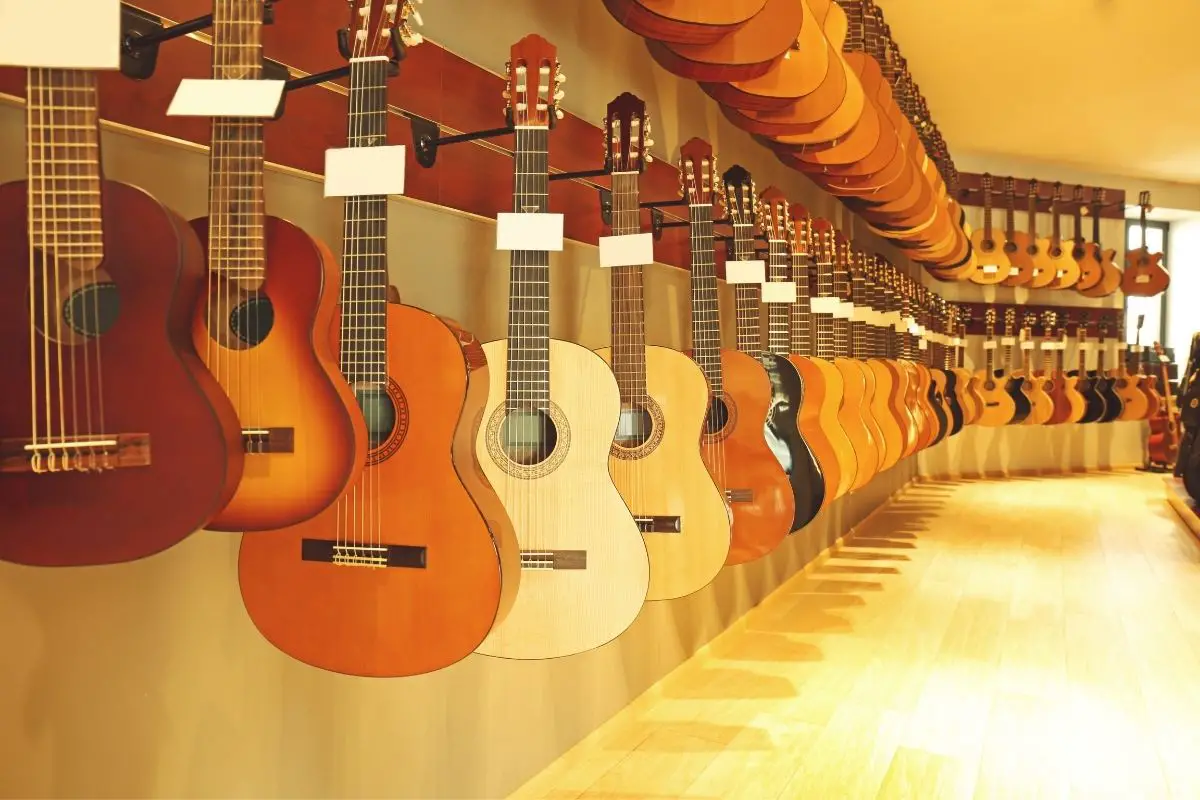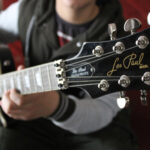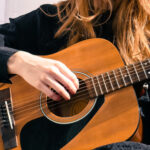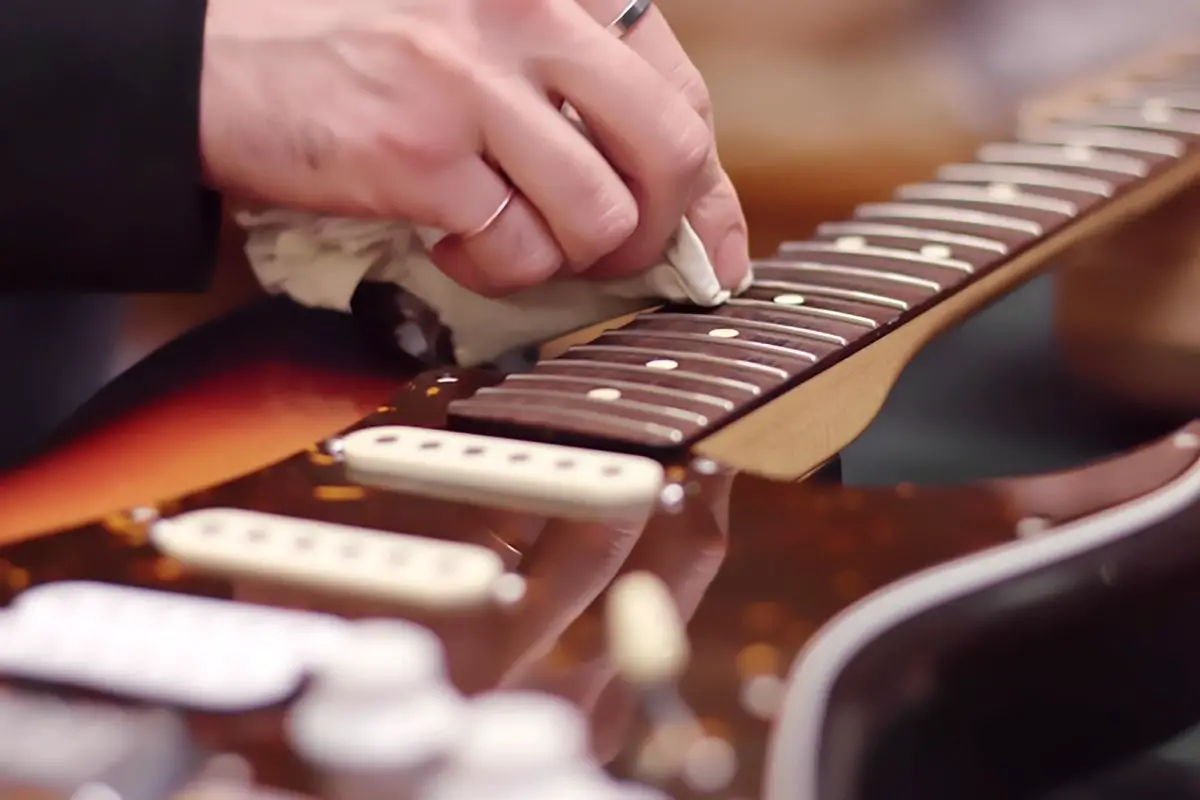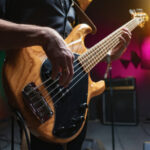Many people who are interested in learning to play the guitar often worry that they have “fat fingers” and that their finger size could be a hindrance to mastering the instrument.
While larger fingers can indeed present challenges, with the right approach, techniques, and equipment, anyone can play the guitar beautifully, regardless of their finger size.
One of the primary concerns for those with larger fingers is fretting the strings cleanly without accidentally muting or touching adjacent strings.
To overcome this, it’s essential to develop a good understanding of how your fingers interact with the guitar and be patient as you practice and refine your finger placement and dexterity.
When faced with challenges while learning the guitar, persistence and determination are key. With consistent practice, ongoing improvement is assured, and soon enough, your fingers will no longer feel like a stumbling block.
Invest time in learning proper techniques and finding the best guitar and setup to suit your unique physiology.
Key Takeaways on How to Play Guitar with Fat Fingers
- Fat fingers can be a concern for guitar learners, but they don’t have to be a hindrance
- Focusing on proper techniques and equipment will help overcome finger size challenges
- Persistence and determination will lead to ongoing improvement and eventual mastery
Check out these other top picks in this category:
- Is Bass Easier Than Guitar
- Should I Still Play Guitar Even When My Fingers Hurt?
- How Many Notes Are On A Guitar?
Understanding the Challenges of Fat Fingers

Playing guitar with fat fingers can present a unique set of challenges. One of the primary difficulties faced by individuals with larger fingers is the unintentional muting or buzzing of adjacent strings.
As a result, guitarists with fat fingers might struggle to play clean and precise chords, especially on a guitar neck with closely spaced strings.
Another challenge faced by guitarists with larger fingers is the difficulty in navigating the guitar neck. It can be hard to quickly and accurately transition between chords and individual notes, as the limited space between strings and frets can cause fingers to accidentally press or brush against unwanted strings.
In addition to these challenges, guitarists with fat fingers might also encounter discomfort while playing different types of chords. Stretching fingers to reach frets that are farther apart or forming complex chord shapes that require precise finger placement can cause cramping and hand fatigue.
Despite these challenges, there are several strategies that can help individuals with fat fingers to improve their guitar playing experience. Some of these approaches include using a guitar with a wider neck, increasing string spacing, and employing proper finger placement techniques.
By taking these factors into consideration, guitarists with fat fingers can overcome the obstacles associated with playing the guitar and achieve a more enjoyable and rewarding musical experience.
Choosing the Right Guitar
One of the first things to consider when learning how to play guitar with fat fingers is choosing the right guitar. The type of guitar you choose can significantly affect your playing experience.
There are three main types of guitars: acoustic, classical, and electric guitars, each with unique characteristics that may suit your needs.
Generally, players with larger fingers should opt for a guitar with a wider neck. The neck of the guitar, where your fingers press down on the strings, can vary in width, making it easier or harder for those with bigger fingers to play comfortably.
Some brands, such as Gibson and Fender Strat, offer specific models with wider necks to accommodate players with larger hands.
For example, the Gibson Les Paul typically has a wider neck than a Fender Strat, making it more suitable for those with larger fingers. Classical guitars also tend to have wider necks, which can be an excellent option for beginners learning to play with bigger fingers.
When it comes to acoustic guitars, Seagull offers a range of models with neck widths that are friendly for players with larger hands.
Aside from the neck width, it’s essential to consider the body of the guitar. Some guitars have a larger body, which may be more comfortable to hold and play if you have bigger hands.
Trying out multiple guitars in person at a store can help you find the perfect instrument that fits your needs and preferences. Pay attention to the shape and size of the guitar’s body and how it feels when you hold it.
Optimizing Guitar Setup
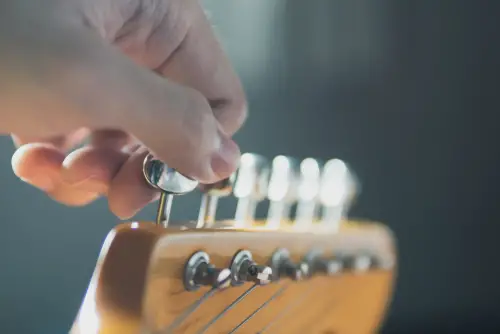
Playing guitar with fat fingers can be challenging, but optimizing the guitar setup can significantly improve playability. Making adjustments to the strings, action, nut, nut width, fretting, frets, bridge, and wider necks can make it easier and more enjoyable to play the guitar.
Choosing the right strings can make a considerable difference. Opt for lighter gauge strings as they are easier to press down, reducing tension and allowing for smoother fretting. Experiment with different string materials, as some materials offer a slicker feel, providing more comfort while playing.
Adjusting the action, or the height of the strings off the fretboard, is crucial for fat finger players. Lower action is preferable, as it reduces the distance needed to press down the strings for clear notes. However, beware of setting the action too low, as it can cause fret buzz.
The nut, located at the end of the fingerboard, plays a significant role in comfortable fretting for fat fingers. Opt for a nut with a wider width, allowing for more space between strings. This extra spacing minimizes the likelihood of accidentally muting neighboring strings while fretting.
Frets come in various sizes and materials, so selecting the right frets for your guitar can make a difference in playability. Jumbo frets often provide a better playing experience, as they allow for more precise finger placement and reduce the pressure needed for fretting.
Adjusting the guitar’s bridge can also influence playability. Some guitar bridges offer adjustable string spacing, which can provide additional room between strings for fatter fingers. Experimenting with different bridge types can help find the optimal setup.
Finally, consider wider necks—often found on classical guitars—for more room between strings when fretting. Wider necks provide extra space to accommodate fat fingers and enhance overall playability.
Techniques for Hand and Fingers
Playing guitar with fat fingers can be challenging, but with the proper technique and practice, it is certainly achievable.
This section focuses on various methods for improving hand and finger positioning, increasing dexterity, and incorporating stretching exercises to overcome any difficulties associated with having larger fingers.
Firstly, hand position plays a crucial role in effectively playing the guitar with fat fingers. It is important to keep the fretting hand relaxed and correctly positioned to avoid unnecessary strain and to allow fingers to reach the intended frets and strings.
One helpful tip for proper hand positioning is to position the thumb behind the neck of the guitar, providing additional support and leverage for the fretting hand.
It’s also essential to consider finger position when playing guitar with fat fingers. When fretting notes, the fingertips should be placed as close to the fret as possible without touching it. This ensures that the fingers do not accidentally mute or bend other strings, allowing for cleaner and better-sounding notes.
Dexterity is another key aspect when playing guitar with fat fingers. Regularly practicing guitar exercises that focus on improving finger strength, flexibility, and independence can make a significant difference in how smoothly you play.
Examples of such exercises include scale patterns, chromatic exercises, and coordination drills.
Incorporating stretching and finger stretching exercises into your practice routine can help with any discomfort or stiffness that you may experience. Stretching the fingers, wrists, and forearms can improve flexibility and promote a more relaxed approach to fretting notes.
Techniques, like taking breaks to shake out your hands and fingers, or using a stress ball to strengthen your hands, can be helpful in reducing muscle tension.
Following the correct way to hold a guitar can also contribute to overcoming any challenges associated with having fat fingers.
It’s important to find a comfortable and stable position for the guitar, whether sitting or standing. This will encourage proper hand positioning and maintain good posture, reducing the risk of strain or injury.
Playing Techniques

Playing guitar with fat fingers can be challenging, but with the right techniques, even the most robust-handed individual can become a skilled guitarist. Let’s explore some playing techniques that will help those with larger fingers navigate the fretboard more efficiently.
A common problem for beginner guitarists with larger fingers is that they accidentally mute or muffle neighboring strings while fretting.
One technique to combat this issue is to utilize the tips of your fingers when pressing the strings. This will allow for greater accuracy and control, reducing the likelihood of accidentally muting strings.
Another crucial technique is adjusting the position of your hand and wrist. Make sure your knuckles are parallel to the fretboard, allowing your fingers to reach each string more easily.
Experiment with the angle of your thumb on the back of the neck as well, as this can help provide better support for your fingers.
Using a capo can be a huge help for those with larger fingers. By attaching a capo to the fretboard, you effectively shorten the length of the strings, making frets appear closer together.
This allows fingers to more comfortably form chords and can alleviate some discomfort related to reaching around the fretboard.
When developing technique, make sure to pay attention to tone. Many beginner guitarists unknowingly sacrifice tone quality in exchange for speed or convenience. Practice slowly and deliberately at first, ensuring the clear and proper tone is achieved before increasing the tempo.
Finally, be patient and persistent. As with any new skill, overcoming challenges and correcting beginner mistakes takes time and dedication.
Being conscious of your playing technique and making adjustments as needed will ultimately lead to improved playing and a more enjoyable experience on the guitar.
Remember, with consistent practice and focused attention on technique, guitarists with fat fingers can achieve success and overcome any perceived limitations.
Finding the appropriate balance between hand position, pressure, and finger placement will help ensure a smooth learning journey and a more satisfying musical experience.
Posture and Comfort
Playing guitar with fat fingers can be challenging, but by focusing on posture and comfort, one can overcome this obstacle. Proper posture and positioning of the guitar are essential to ensure a comfortable playing experience and to avoid putting unnecessary strain on the hands and fingers.
One crucial aspect of achieving comfort while playing the guitar is the sitting position. A player should sit in an upright position, with their back straight and feet flat on the ground.
Placing the guitar on the dominant leg (the leg corresponding to the strumming hand) can help maintain balance and stability. A footstool or an adjustable guitar stand can also help raise the guitar to a comfortable height.
Another vital component for playing the guitar with fat fingers is the guitar position. The neck should be angled upward, preventing strain on the wrist and making it easier to reach frets. The guitar should be held snugly against the body, with the picking hand providing support and balance.
Additionally, using a guitar strap, even while sitting, can help maintain a consistent position and prevent shifting that might affect finger placement.
Good posture is also essential for playing the guitar effectively with fat fingers. Avoid slouching and keep the shoulders relaxed to minimize tension in the neck and arms. Placing the thumb behind the neck and supporting it with the fingers helps create enough space to play the strings comfortably.
Keeping the wrist straight, relaxed, and creating an arch between the thumb and fingers can further improve fretting accuracy and reduce stress.
Practice Strategies

One of the key factors in learning to play guitar with fat fingers is consistent practice. Establish a routine and dedicate time to practice. This will help in improving finger strength and dexterity.
Stretching exercises are essential for individuals with larger fingers. Incorporating finger stretching into the practice routine allows for increased flexibility and reach on the fretboard. It also aids in preventing injuries. Perform these exercises before and after each practice session to maintain finger health.
Developing calluses will make playing the guitar more comfortable. Calluses form on the fingertips through consistent practice and serve as natural cushions, allowing for smoother chord transitions and better playability.
To expedite this process, one might consider using a grip strengthener or playing for short periods several times a day.
There are several tips and tricks to help those with chunky fingers navigate the guitar. First, try utilizing lighter gauge strings, as they require less pressure to fret and subsequently lower the chances of accidentally muting adjacent strings.
Additionally, consider angling the fingers and using the tips rather than the pads creates more space between the strings and reduces the likelihood of unintentional contact with neighboring strings.
Success Stories
Django Reinhardt, a famous jazz guitarist, managed to overcome his physical limitations to become a renowned musician. Despite having lost the use of two fingers in a fire accident, he developed the unique technique of using only his index and middle fingers.
Nevertheless, his remarkable dexterity allowed him to create unforgettable melodies, making him an inspiration for many aspiring guitarists.
Johnny Hiland, another accomplished guitarist, has also faced physical challenges, as he was born with a condition called nystagmus, which affects his eyesight. Despite his limited vision, he found success in the world of country and blues guitar.
Johnny’s innate talent and dedication to his craft has led him to shred on stage with the likes of Ricky Skaggs, John Jorgenson, and Vince Gill.
Other famous guitar players who have pushed past their physical limitations serve as examples of perseverance and adaptability. These musicians have demonstrated that one can excel in playing guitar despite having larger fingers or suffering from injuries.
Instead of being deterred, they’ve honed specialized techniques and found innovative solutions, such as:
- Customized finger positioning: Adapting their hand placement to achieve better reach and control over the strings and frets.
- Alternative tunings: Experimenting with various tuning options that maximize their comfort and dexterity while playing.
- Personalized setups: Adjusting their guitars’ action and neck width to accommodate their unique finger size and shape.
It’s important to remember that physical limitations don’t have to hold you back from achieving success as a guitar player.
As the stories of Django Reinhardt, Johnny Hiland, and other accomplished musicians prove, having fat fingers or other challenges can be overcome with dedication, practice, and a willingness to adapt.
So keep refining your techniques, experimenting with new ideas, and always strive for excellence on your musical journey.
Conclusion
Choosing the right guitar for individuals with fat fingers is a critical step in ensuring a comfortable and enjoyable playing experience.
Opting for a guitar with a wider neck, such as a classical guitar, provides more space between the strings, making it easier for these guitarists to press down each string without accidentally muting or fretting the adjacent strings.
When it comes to strings, selecting lighter gauge strings will reduce the pressure required to press down on the fretboard, leading to a more effortless playing experience.
Additionally, experimenting with different string materials, such as flatwound or coated strings, can prove beneficial in improving comfort for players with larger fingers.
Many renowned guitarists have faced the challenge of playing the guitar with fat fingers, proving that overcoming this obstacle is entirely possible.
By choosing a suitable guitar, opting for appropriate strings, and dedicated practice, individuals with fat fingers can successfully master the art of guitar playing.
Frequently Asked Questions
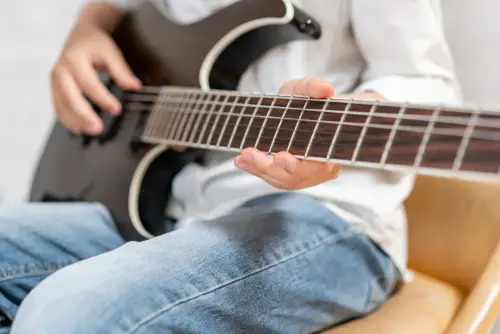
Can short stubby fingers play guitar effectively?
Yes, individuals with short, stubby fingers can play guitar effectively. Even though it might be more challenging at first, with dedication, practice, and the right techniques, one can become a skilled guitarist.
It is key to be patient and persistent while developing muscle memory and finger strength.
How to stretch fingers for better fretboard reach?
To improve fretboard reach, it is vital to perform regular finger stretching exercises. Place fingers on the frets

My name is Howard Matthews and I have been playing the guitar since I was knee-high. My parents like to joke that I was pulling the strings even before I was born. In fact, one of my earliest memories is sitting on the couch with my dad’s guitar, wreaking havoc on the chords.
Now, 40 years later, I can attest that I play them much better than I did back then. I have followed in the footsteps of both my parents – much to their delight – and have been the main guitarist in my band for the best part of three decades.
Music has always been my passion, and until recently my life has been so consumed with it that I haven’t had a moment to have a breath (and I wouldn’t have it any other way)!

